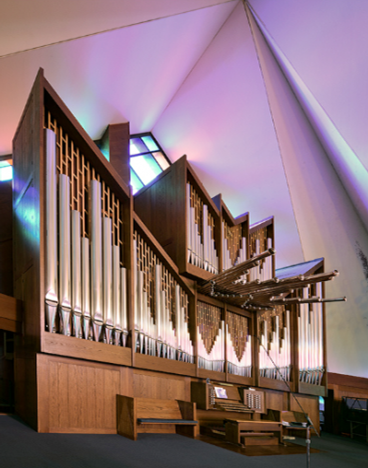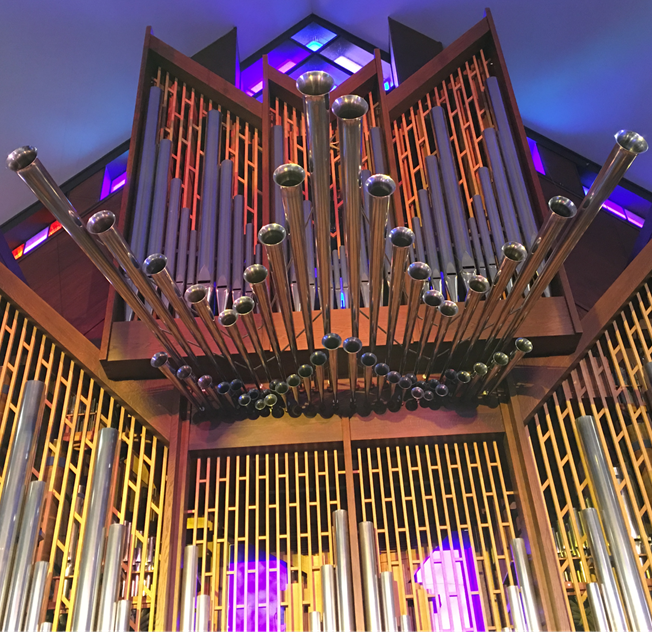
 The Marcussen Organ was installed in First United Methodist Church of Fort Collins in 1987 by the Marcussen Organ Company of Aabenraa, Denmark. It utilizes all of the technology that was available at that time to enhance and expand upon those refined principals of organ building that have evolved over many centuries. The tonal disposition was designed by Robert Cavarra, who acted as Consultant to the Organ Selection Committee, in collaboration with Olav Oussoren, Tonal Director for the Marcussen firm at the time. Mr. Oussoren was also responsible for the scaling of the pipework and the physical layout of the organ. He, together with Emil Bladt and Robert Cavarra did the final tonal finishing.
The Marcussen Organ was installed in First United Methodist Church of Fort Collins in 1987 by the Marcussen Organ Company of Aabenraa, Denmark. It utilizes all of the technology that was available at that time to enhance and expand upon those refined principals of organ building that have evolved over many centuries. The tonal disposition was designed by Robert Cavarra, who acted as Consultant to the Organ Selection Committee, in collaboration with Olav Oussoren, Tonal Director for the Marcussen firm at the time. Mr. Oussoren was also responsible for the scaling of the pipework and the physical layout of the organ. He, together with Emil Bladt and Robert Cavarra did the final tonal finishing.
The visual design of the organ is every bit as stunning as its musical properties. The organ case was planned by the Marcussen artisans to complement the interior of the sanctuary. Taking its motif from the general shape of the room (the wood panels down the nave, the right angles of the window design) the case, with its gleaming pipework blends completely with the architecture of the interior of the church building. The elegant case is highlighted by the pipes of the Spanish Trumpet, mounted horizontally below the Swell organ. The pipes of the Great 8’ Hulfløjte stand in the front of the Swell division. Directly below the Swell, in the center, is the Positive division, with its 4’ Principal pipes in the case above the organist. To the left and right of the Positive sits the Great organ with its 8’ Principal pipes mounted in the façade. Finally, the Pedal division is on either end of the case. Its 16’ Principal stands in prospect at the front of the case. Placement of the Principal pipes in the façade of the organ serves a musical function as well as a decorative one, for it places the most important rank of each division in the most acoustically prominent position. A gilt star, located high in the center of the Swell division, rotates when the Cymbelsterne is drawn. This is a stop that plays several triangles in a delicate musical pattern.
The tonal design of the Marcussen organ is comprehensive, encompassing the totality of the great organ literature so that the organ plays all styles of every country and period. Its 46 speaking stops control 62 ranks of pipes, chimes, and Cymbelsterne. There are a total of 3325 pipes in the organ.
The principal choruses, the most important collection of stops in any organ are bright, articulate, and transparent, and are wonderfully balanced from bass to treble so that the rich contrapuntal literature is heard with clarity throughout all of the parts. While an integral part of the organ writing of all styles, the sounds of the principal chorus are essential to the execution of the organ works of the North German Baroque, culminating in the works of Johann Sebastian Bach.
The rich complement of reeds, from the wonderfully quaint sounding Vox Humana and Cromorne, through the several chorus and solo reeds (the Swell Obo and Trompette, the Great Trumpet, and the Pedal Basun, Dulcian, Trompet and Skalmeje), to the brilliantly firey sounds of the Spanish Trumpet, provides the organist with a vast array of tonal color suitable to the Classic and Romantic French styles, as well as the early organ music of Spain and Germany. Of course, it plays all of the Contemporary literature as well.


The most remarkable dimension of this superb organ is its sensitive and highly controllable action. Using direct mechanical linkage, called “trackers”, between the keys and the valves, the organist has direct control over the quality of response from each of the pipes. The control of pipe speech is so apparent and the touch so responsive that this organ puts to rest once and for all the dispute that mechanical key action allows for musical control of pipe speech. Control of how musical sounds begin is essential to all musical instruments. This kind of control for the organ is only possible with fine mechanical key action such as this Marcussen Organ possesses.
As one of the finest church organs in the region, the Marcussen Organ at First Methodist serves as a model for fine organ building to this day. Its glorious voice has brought joy and inspiration for many generations and will do so for many generations to come as it sings its praises “Soli Deo Gloria” - for the Glory of God. The Marcussen Organ at First United Methodist Church was the dream of the many faithful who gave so generously of themselves so that this organ could become a reality.
The Organ Committee included: Joe Mutti, Bill Emslie, Paul Bell, Jack Rowe, Rev. Robert Hamilton, Genevieve Broad, Robert Cavarra, Aleatha Deal, Jud Harper Pat Harper, Patty Bell, Alyce Kaehler, Buford Plemmons, Earl and Vera Hogan, Jim Boyd, Susan Neff, Jan and Fred Owen, Jim Loftis, Dick Fahrenbruch, Lenore Hample.
- Taken directly from the unedited notes included in the dedicatory concert brochure (June 1987).

